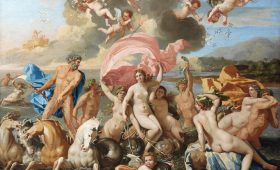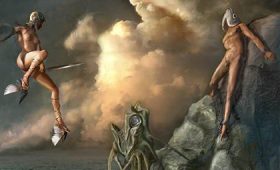Galatea2.0100_MeissenKaendler
Johann Joachim Kaendler, designer, Galatea tureen, part of the Swan Service produced at the Meissen Porcelain pottery (Staatlich Porzellan-Manufaktur Meissen), 1740.
Kaendler’s elaborate soup tureen depicts the mythological sea-nymph Galatea atop a fish and attended by other marine divinities and several swans. Attributes are lacking by which one might identify specifically Galatea, except the title of the piece and the similarity to Kaendler’s sourcworks — (according to Helfricht they are Francis Barlow’s drawing (1626-1704) and Francesco Albini’s pa
inting “Galatea in a Shell Chariot” (1578-1660). Images featuring the sea-nymph Galatea triumphans were hardly uncommon in 16th– thru 18th-century art, e.g. Raphael’s Triumph of Galatea (1511), An. Carracci’s “Polyphemus Wooing Galatea” (ca. 1596), Domenico Fetti’s Galatea and Polyphemus (1621) or J-B van Loo’s Triumph of Galatea (1720) among many similars.

Under direction of Heinrich Graf von Brühl, the Meissen factory produced a highly influential porcelain tableware service, the Schwanenservice (1737-1742) consisting of more than 2,200 individual pieces. The individual pieces of the collection feature swan motifs generally, but include also diverse other mythological tropes. Brühl’s leadership and the Swan Service established the Meissen factory as an important purveyor of luxury goods but, more broadly also, an artistic influence in 18th-century Europe and beyond.
Such items as Meissenware and Wedgwood products are not generally indexed in the Oxford Guide to Classical Mythology in the Arts. (Nor is this item found in the print version.)
The featured image is included in J. Helfricht (2012), A Small Lexicon of Meissen Porcelain [tm] (Husum), 113.
<p><a href=”https://ogcma.byu.edu/Galatea2.0100_MeisenKaendler.htm”>Galatea2.0100_MeissenKaendler</a></p>
Galatea2.0098_Albini
Galatea2.0099_Barlow
Galatea1.0031_CarracciAnnibale
Francis Barlow, British, Lincolnshire ca. 1626-1704, illustrated Ovid’s Metamorphoses, Aesops’ Fables and many other print publications in the 17th Century. His works were used extensively by 18th-century artists such as the designers at the Meissen porcelain factory.
Francesco Albini doesn’t appear in Michael Bryan’s Dictonary of Painter and Engravers (or any other place I’ve checked).
Annibale Carracci’s ceiling fresco in Palazzo Farnese (1596-1597) would seem to have all the elements for Galatea (wind-blown drape, two attendants upon a cruising dolphin) to serve at source or inspiration for Kaendler’s work. (https://library.artstor.org/#/asset/SCALA_ARCHIVES_1039778737)



